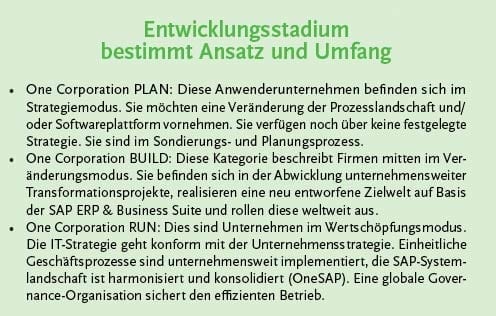How does S/4 fit into my plan?
![[shutterstock.com:258191714, Ruslan Grumble]](https://e3mag.com/wp-content/uploads/2016/09/shutterstock_258191714_green_CMYK.jpg)

Globalized markets, growth, acquisitions and mergers generate constant pressure to change. Companies have been standardizing their business processes and system landscapes for some time.
The trend is toward control-optimized One Corporation on a unified OneSAP enterprise platform.
According to the results of the Corporate SAP Application Management market study among industrial companies in the DACH region (cbs, 2015), 83 percent of companies already use a global SAP system as their central IT platform.
However, the globalization of this solution has not yet taken place comprehensively. In many system landscapes, historical, regional and local SAP systems still coexist with the globally conceived ERP.
There is therefore still a need for rollouts in the SAP environment. At the same time, the consolidation of system diversity is on the agenda.
Organizational changes also act as drivers for technical restructuring of the SAP system environment.
SAP is currently driving a technological paradigm shift at a rapid pace of innovation. With Hana, the in-house in-memory database is on its way to becoming the de facto standard for databases for SAP application systems.
SAP S/4 Hana Enterprise Management is about to replace the long-serving R/3 system. The successor is here: S/4 is the ERP of the future.
A new generation of SAP Business Suite on Hana, new simplified applications for finance and logistics, and alternative cloud operating models are fundamentally changing the world of SAP business solutions.
So it's clear: Sooner or later, every IT manager will have to deal with S/4 Hana. Only the timing is the question. Is there cause for composure or is haste called for?
To find out, it is first necessary to properly understand the impact of this paradigm shift on one's own company and to compare the resulting urgencies, constraints and opportunities with one's own corporate reality.
The central questions here are: How does S/4 Hana fit into my IT strategy and SAP construction planning? In what way do I therefore need to plan and design my changeover?
Driving the corporate agenda
There is no patent remedy for switching to the new ERP. Too much depends on the development status of the existing process and system landscape and the strategic orientation of the company.
The choice of approach is crucial. It can be understood and pursued in purely technical terms, as an upgrade or migration of an existing ERP system to the new S/4 platform.
A defined sequence of individual steps for system preparation then leads there. In many cases, however, this falls short. Instead, the switch to S/4 Hana should be viewed holistically and designed with value in mind.
SAP customers would do well to consciously place the issue in the context of their overarching strategic goals and requirements from the perspective of the company as a whole. This is simply a matter of calculation.
For IT, S/4 Hana offers the opportunity to use the profound change in what is probably the most important IT platform to realign the IT strategy with the corporate strategy in a new and precise way. This opportunity must be used in the best possible way. But how?
The consulting approach "cbs S/4 Hana Transition Program" supports globally active companies in strategically using the changeover to SAP S/4 Hana not as an isolated IT initiative necessary in the short or medium term, but as part of the corporate agenda.
The key here is to bring together the business agenda, IT strategy, and SAP innovations around S/4 Hana in a methodical and structured way. S/4 should be seen as the cornerstone of the future: the core of the enterprise platform that will carry the "One Global Corporation" of tomorrow and drive the Digital Company forward.
Understand effects
SAP S/4 Hana does indeed bring fundamental changes. Several levels are affected: IT strategy, BI strategy and architecture, new core applications and functionalities with their consequences for process design, plus a new data model with correspondingly changed table and data structures, which have an impact on Abap coding and in-house developments, database and infrastructure.
All of this must be considered in detail. It is important to determine exactly which influencing factor has an effect, with what urgency and to what extent, and to make a corresponding classification for one's own company.
Find the entrance
However, the decisive anchor point for the orientation of the project strategy is not software-bound, but company-related: It is the starting position and future orientation of the companies concerned.
The question "When is the right period for the changeover?" can only be answered on a company-specific basis. On the one hand, the right answer depends on the strategic horizons of the company: on the long-term objective, on the medium-term plans and on both upcoming and ongoing projects in the short term.
Another influencing factor is the state of the existing process and system landscape in connection with the maturity level of the global organization.
The S/4 Hana Transition Program uses a distinction into three typical development stages. These illustrate where a company currently stands in terms of the strategic alignment of business goals and IT/SAP support.
The right time
"When is a company ready for a new renovation of its process and system landscape?" is one question. "When is the S/4 Hana software ready for use in my industry?" is the other. The intersection where both development paths meet in the future is the ideal time for the company - the so-called "sweet spot" to tackle the switch to the new S/4 software generation. This cannot be predicted exactly. But it can be predicted well enough to draw reliable conclusions for planning. The "cbs S/4 Hana Transition Program" makes such a deduction in a company-specific and structured manner. Based on this, the project approach is to be determined. The target architecture is to be derived. An implementation plan - the transition roadmap - must be created.
Greenfield or Brownfield
Are business processes to be redesigned and standardized to a high degree? Is it a question of setting up a completely new system landscape, or is it a question of using an existing system line that is to be lifted onto S/4 Hana?
The strategic baseline provides the framework for answering these questions. The specific system determines the project character and the project approach. It determines how strongly the business must be involved in the design responsibility and to what extent the company has to manage a business and IT project.
The "cbs S/4 Hana Transition Program" uses the M-cbs method to derive the company-specific project approach in a structured and internally consistent manner in coordination with the relevant stakeholders.
Hybrid future
The entire SAP solution architecture is changing. The cloud is gaining in importance. The classic on-premise business is expanding to include the Hana Cloud Platform (HCP), Hana Cloud Integration (HCI) and solutions such as Cloud4Customer (C4C), Hybris and Ariba.
The future lies in hybrid architectures. There will be functional shifts. Large process blocks will migrate to the cloud, such as CRM, or will move within applications, as in logistics and foreign trade.
How do I integrate cross-application business processes in my hybrid system landscape? How do I enable mobile data access, the connection of my business partners in my supply chain, the realization of new scenarios such as IoT?
In hybrid architectures, the issue of security is gaining in importance. A correspondingly comprehensive architecture planning must be carried out.
Transition Roadmap
Once the project approach and rough target architecture have been determined, the necessary preparatory and implementation measures must be defined, packaged and put in a sensible chronological order.
How can the projects be presented in a business case and mapped in an overall budget? A high-level S/4 Hana transition roadmap initially helps companies to roughly plan their path so that they can subsequently further detail and specify it.
As part of a preliminary study, a precise, individual business case is then created, the company's "S/4 Hana Transition Program": It is the targeted, resilient implementation program for the new future platform.






